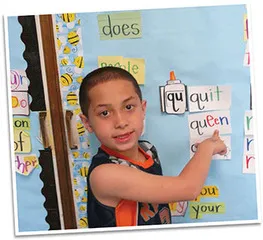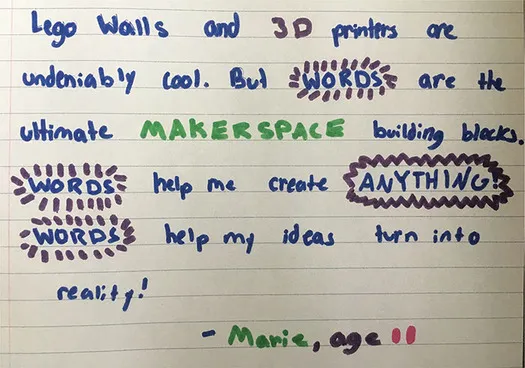
eBook - ePub
The Word Study That Sticks Companion
Classroom-Ready Tools for Teachers and Students, Grades K-6
Pamela A. Koutrakos
This is a test
Share book
- 304 pages
- English
- ePUB (mobile friendly)
- Available on iOS & Android
eBook - ePub
The Word Study That Sticks Companion
Classroom-Ready Tools for Teachers and Students, Grades K-6
Pamela A. Koutrakos
Book details
Book preview
Table of contents
Citations
About This Book
K ickstart joyful independent word study practice in your K–6 classroom Pamela Koutrakos offers a plethora of tools and ready-to-go resources to help teachers put the inquiry-based structures, lessons, and routines she delivered in her first book, Word Study That Sticks, into action. Loaded with teacher-facing resources such as planning and assessment tools, and student-facing tools such as reproducible minicharts, choice checklists, and self-assessments, The Word Study That Sticks Companion includes routines and materials that can be used within any word study curriculum. Let students take charge of their learning while you gain time for differentiated instruction, and make word study fun for students!
Frequently asked questions
How do I cancel my subscription?
Can/how do I download books?
At the moment all of our mobile-responsive ePub books are available to download via the app. Most of our PDFs are also available to download and we're working on making the final remaining ones downloadable now. Learn more here.
What is the difference between the pricing plans?
Both plans give you full access to the library and all of Perlego’s features. The only differences are the price and subscription period: With the annual plan you’ll save around 30% compared to 12 months on the monthly plan.
What is Perlego?
We are an online textbook subscription service, where you can get access to an entire online library for less than the price of a single book per month. With over 1 million books across 1000+ topics, we’ve got you covered! Learn more here.
Do you support text-to-speech?
Look out for the read-aloud symbol on your next book to see if you can listen to it. The read-aloud tool reads text aloud for you, highlighting the text as it is being read. You can pause it, speed it up and slow it down. Learn more here.
Is The Word Study That Sticks Companion an online PDF/ePUB?
Yes, you can access The Word Study That Sticks Companion by Pamela A. Koutrakos in PDF and/or ePUB format, as well as other popular books in Bildung & Grundschulbildung. We have over one million books available in our catalogue for you to explore.
Information
Part I Launching Curious, Creative Word Study




Chapter One Building Vision for Word Learning

When we set up rich opportunities for word exploring and support student independence, students start to feel differently about words.
Word study instruction embedded in best practices and relevant for students today? It does exist! We’ve learned that traditional approaches (the isolated spelling lists and spoon-fed vocabulary definitions, and rote drills of yesteryear) don’t help learners progress. They don’t stick. They don’t elicit collaboration, deep inquiry, engaging conversation, or a playful stance. Now is the time for word study routines that are collaborative, curiosity-driven, and designed for learners to take to the next level. With Word Study That Sticks (Koutrakos, 2018), and this companion book, I set out to prove that you can have your cake and eat it too. We can support students’ developing language skills each day with rigor and joy!
- Step 1: Learn about the research, ideas, and approach to this stepped-up approach to word study in Word Study That Sticks.
- Step 2: Use this book, The Word Study That Sticks Companion, to clear the path, pave the way, and help you put this approach into practice!
Get ready, get set, now is the time to GO.
Teaching and Tools Make for a Purposeful Partnership
Teaching tools will not be the answer to every problem you face in your classroom, nor will they all by themselves create rigor and independence just by being in your students’ hands. You will also need good teaching practices, a strong curriculum, and solid relationships with your kids. But … teaching tools are powerful assistants along the way. (Roberts & Beattie Roberts, 2016, p. 5)
Here is a not-so-secret secret: Most programs don’t support meaningful, personalized, authentically engaging learning. Tools alone also won’t do the trick. You are the expert on the students you observe, talk with, laugh with, and learn alongside. Colorful, boxed materials and cutesy, downloadable “stuff” could never replace you or your expertise. Teaching and learning are built upon connection, relationships, and responsiveness. Working alongside students takes tremendous patience, creativity, experimentation, and flexibility. It is our practiced skill set, commitment to continual professional growth, and knowledge of each unique group of learners that guide strong teaching and responsive decision making.
This companion text contains a plethora of resources to support the stepped-up approach to word learning presented in Word Study That Sticks. But please remember that tools alone are unable to provide a complete picture of what word learning looks like, sounds like, and feels like. Perhaps most important, resources (even those of high quality) do not share the complete “why” teachers crave to back up their instructional decisions and practices. As Kate and Maggie Beattie Roberts share in the quote above, tools are there to assist. When used in conjunction with the strong instruction outlined in Word Study That Sticks, these resources will amplify student learning and increase independence and success.
To that end, in this book, you will find the following:
- Advice to make rolling out word study more successful than you had originally hoped
- Resources to greatly minimize the time you spend preparing, creating, and revamping
- Tools that will help students empower themselves and create more of their own successes
Multifaceted Word Study
Many people think of word study as spelling. Although spelling plays a critical role in word study, this view ignores the bigger picture and important factors such as the role of orthographic knowledge in reading and writing, the importance of oral language and vocabulary knowledge for reading and writing, and the interrelatedness of reading and writing. (Ganske, 2014, p. 4)
Word study is not just one thing. The study of words includes nurturing phonemic awareness, building a strong phonics foundation, studying word parts and patterns, and studying actual words. I believe that anything learned in isolation stays there. As such, for word study to stick, we need to integrate different facets of word study into our instruction. Furthermore, we also need to study words throughout the day, not just in a tiny window of our day labeled word study.
Vocabulary building is a key component to word study. Students need a strong handle on the meaning of words (including lesser-known definitions), contexts for using words, and opportunities to use words (and their knowledge of how words work) in authentic conversation, reading, and writing. This is as much a part of word study as studying how words look and sound and the why behind these visual and auditory features.

Each facet of word study is essential and, furthermore, interrelated.
Source: Koutrakos, P. (2018). Word Study That Sticks. Thousand Oaks, CA: Corwin.
However, perhaps more than anything else, a truly student-centered approach to word study most emphasizes teaching the mindset, habits, and behaviors of one who is curious about and interested in discovering more and more about words. This is what’s laid out in Word Study That Sticks—structures, lessons, and routines that promote inquiry-based, joyful word learning.
Organizing Our Time: Creating a Cycle of Word Learning
A1: Many Ts say time is the challenge, but if we view our schedule by the week rather than just day … there is always time. #G2Great. (Howard, 2018)
Teachers and schools have made the thoughtful choice to move away from one size fits all instruction. However, even when we trust and believe in this approach to teaching, it can feel overwhelming to organize our time and provide equitable support to all classroom learners. In word study, as we plan to meet with small groups of learners, it is helpful to think in cycles as opposed to a daily or even a Monday through Friday schedule. Cycles help us organize our time with greater efficiency and less stress. By using a cycle model (like those shown below), teachers are freed up to meet with different learners on different days. As a result, all learners get equal billing in the classroom. Learners receive appropriate and meaningful instruction. Learners grow and progress. And learners experience greater success. When we make the time to observe what is happening in classrooms, listen to, and meet with students, we become truly student-centered in our approach. Cycles help us make this all happen!
I have often found having a “mentor text” to lean on helps me feel ready and inspired to consider how a new practice might look. Building my vision of how others have done this work enables me to feel more prepared and ready to start. To that end, I have included three different examples of cycles I have used in word study at different points in my career. I invite you to look over these mentor texts. Consider your style of teaching and the personalities and next steps of the group of learners you currently work with. Then, tweak and twist the following starting suggestions.
Primary

Elementary

Upper-Elementary and Middle Grades

Source: Koutrakos, P. (2018). Word Study That Sticks. Thousand Oaks, CA: Corwin.
Schmoker (2001) offers poignant words of advice in his article “The Crayola Curriculum.” He reminds us that the reality is that many classrooms have way too much stuff taking the place of meaningful literate activities. Often, the problem is not how much time we have but we how we spend that time. When more time is not possible, we have two choices: Wish and hope … or make a new choice. Worksheets and word search puzzles take up precious minutes that can be spent engaging in more dynamic word-centered practices. We can ...